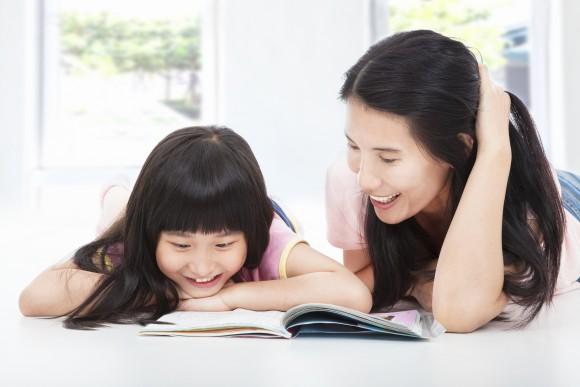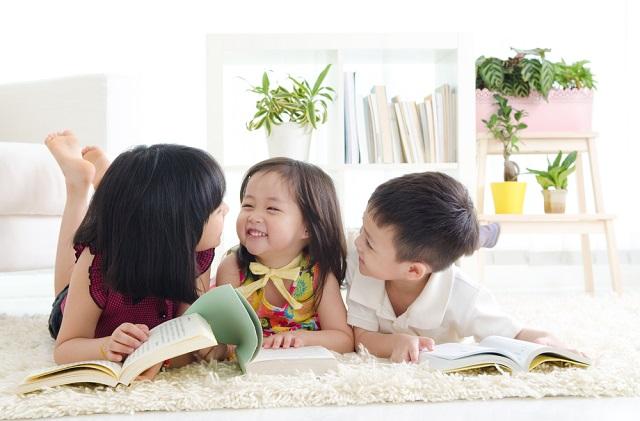【至fun閱讀】窺探視覺文學
2017-04-07

培養一輩子的閱讀習慣是邁向學術成就最重要的一步。閱讀是人生最大的樂趣之一,書本則是我們的良師益友,為我們提供心靈的慰藉及指導。
家長應該鼓勵子女以消閒及享受樂趣為閱讀的首要目的。很多學生反映,他們偏好閱讀有視覺元素的書籍,如漫畫及視覺文學。視覺文學即指包含不同的插畫及圖片的書藉,圖文並茂地繪畫出故事的內容。
家長不該對漫畫及視覺文學抱有成見,繼而限制子女的閱讀選擇。視覺文學是種深受歡迎的讀物,能巧妙地利用圖像來令讀者更投入故事情節。此類文學的體裁十分多元化,涵蓋小說及非小說類的主題,如科學、歷史、生物及數學,表現方式亦集視覺藝術、文字及設計於一身。視覺文學的特點有:
-區隔 — 故事情節以正方形或長方形分隔開
-空位 — 不同分隔中的空間
-對話框 — 引用對話或故事角色的思想
當我們閱讀視覺文學時,必須閱讀文字及圖像。我們應先閱文字,再看圖像;由上至下,左至右(就像一般閱讀英語的習慣)閱讀。此類讀物充分運用整頁的空間,把文字及視覺元素分隔成不同的區隔,並以區隔的數量及大小來控制故事發展的速度。版面設計(字型)風格、顏色及大小掌控說話的語調,所以粗體、大階及不同顏色的文字均有強調句子或製造聲效的作用,如我感受到愛了(I’M IN LOVE),或隆!(BOOM!)。

很多漫畫及視覺文學都同時由文章及帶有強烈美學元素的藝術品構成。視覺文學有助讀者建立重要的圖像素養。家長應該主動了解子女的閱讀興趣,並參與他們的閱讀過程。這個活動促進親子溝通,讓子女在課堂外都能與家長討論讀物內容。以視覺文學為例,家長可以與子女討論書本的視覺元素、設計、劇情、(小說裡的)角色及故事背景。書本的區隔、空位及對話框怎樣互相配合呢?當中的文字及插圖是否有不同含義呢?討論過後,您或許會發現,您的子女對自己有動力閱讀及您有參與討論的書本更投入,從而有更大的得著,您亦會因此而感到驚喜呢。要達成這個目標,視覺文學是您們踏出第一步的最好選擇。
視覺文學作品
針對較年輕的讀者(幼稚園至五年級):
- Tippy and the Night Parade, by Lilli Carre;
- Dinosaurs in Space, by Pranas T. Naujokaitis;
- Giants Beware, by Jorge Aguirre;
- BirdCatDog, by Lee Nordline;
- Fangbone!, Third Grade Barbarian, by Michael Rex;
- Explorer: the Hidden Doors, by Kazu Kibuishi;
- Benjamin Bear in Bright Ideas! , by Philippe Coudray;
- Random House Step Into Reading系列書藉
針對較年長的讀者(六年級及以上):
- Cardboard, by Doug TenNapel;
- Foiled! and Curses: Foiled Again! , by Jane Yolen;
- Astronaut Academy, by Dave Roman;
- Sisters and Smile, by Raina Telgemeier;
- American Born Chinese, by Gene Yang;
- Calamity Jack and Rapunzel’s Revenge, by Shannon and Dean Hale;
- Trinity: A Graphic History of the First Atomic Bomb, by Jonathan Fetter-Vorm;
- The Adventures of Robin Hood and Three Cheers for Inventors, by Marcia Williams;
- Steve Jobs: Genius by Design, by Jason Quinn;
- Primates; the fearless science of Jane Goodall, Dian Fossey, and Biruté Galdikas, by Jim Ottaviani。
References and further reading:
Crowley, J. (2015). Graphic novels in the school library: using graphic novels to encourage reluctant readers and improve literacy. The School Librarian, 63(3), pp. 140-142.
Galda, L., Liang, L.A. & Cullinan, B.E. (2015). Literature and the Child. (9th Ed.). Boston: Cengage Learning.
Herald, N. (2011). Graphic novels for young readers: a genre guide for ages 4-14. Santa Barbara, California: Libraries Unlimited.
Hughes, J. & Morrison, L. (2014). The evolution of teaching with graphic novels. Jeunesse: Young people, texts, cultures, 6(2), pp. 116-127.
Lesesne, T.S. (2016). Graphic novels educators guide. http://www.randomhouse.com/teachers/resource/graphic-novels-educators-guide/
McCloud, S. (1993). Understanding Comics; the invisible art. New York: Harper Collins.
作者:Jennifer Ford @至fun閱讀

Jennifer十分喜愛閱讀,取得英國文學博士及兒童圖書管理碩士學位。現於香港大學教授有關兒童文學的碩士課程。她亦曾在牛津大學出版社出版書藉及於Australian Library Journal和the Oxford Literary Review出版文章。
©2017 JENNIFER FORD ALL RIGHTS RESERVED
相關文章:
Reading Graphic Novels
A lifelong habit of reading books is one of the greatest indicators of academic success. It is also one of life’s greatest pleasures and books can be friend, comforter, educator and mentor throughout life.
It is crucial that parents encourage reading for interest and pleasure. Many students prefer to read in a format that is more visual, such as comics, or ‘graphic novels’. The ‘graphic’ in ‘graphic novel’ simply means that there are images and pictures and that the story is told in pictures as well as in words.
Try not to let any preconceptions of comics or graphic novels limit you or your child’s reading. Graphic novels are a popular, clever, engaging and attractive format for young readers and include fiction as well as nonfiction subjects such as science, history, biography and mathematics. Graphic novels are a unique combination of art, text and design. Elements of graphic novels include:
- Panels – square or rectangular boxes that contain the action and story;
- Gutters – the spaces between the panels;
- Speech balloons and word bubbles – for dialogue and thoughts.
When reading a graphic novel, read both the words and the images. Read the text first, and then the image, and read from top to bottom, left to right (as you would any English text). Graphic novels use the space of a page to combine words and visuals into sequential panels, with the number and size of panels controlling the pace of the story. Typography (font) style, colour and size are used to communicate tone, so that letters written in bold, upper case letters or different colours would be given more emphasis such as I’M IN LOVE or to convey sound effects such as BOOM!.
Many comics and graphic novels are complex pieces of writing and design with visually stunning artwork. Graphic novels help develop crucial visual literacy skills. Take an interest in what your child is interested in reading, and read some of the same titles with them. It’s a great form of family bonding to discuss books together away from the classroom. For graphic novels, you can discuss the visuals and design of the book as well as the plot, its characters (if fiction) and setting. How do the panels, gutters and speech balloons work together? Are there different meanings between the words and the images? You may be surprised at the kind of responses your child can have to books they are motivated to read and you have taken an interest to read as well, and graphic novels are a great place to start.
Some graphic novels:
For younger readers (K- up to Grade 5):
- Tippy and the Night Parade by Lilli Carre;
- Dinosaurs in Space by Pranas T. Naujokaitis;
- Giants Beware by Jorge Aguirre;
- BirdCatDog by Lee Nordline;
- Fangbone! Third Grade Barbarian by Michael Rex;
- Explorer: the Hidden Doors edited by Kazu Kibuishi;
- Benjamin Bear in Bright Ideas! by Philippe Coudray; or
- various titles in the Random House Step Into Reading series.
For older readers (Grade 6 and up):
- Cardboard by Doug TenNapel;
- Foiled! and Curses: Foiled Again! by Jane Yolen;
- Astronaut Academy by Dave Roman;
- Sisters and Smile by Raina Telgemeier;
- American Born Chinese by Gene Yang; Calamity Jack and Rapunzel’s Revenge by Shannon and Dean Hale;
- Trinity: A Graphic History of the First Atomic Bomb by Jonathan Fetter-Vorm;
- The Adventures of Robin Hood and Three Cheers for Inventors by Marcia Williams;
- Steve Jobs: Genius by Design by Jason Quinn; Primates;
- The fearless science of Jane Goodall, Dian Fossey, and Biruté Galdikas by Jim Ottaviani.
References and further reading:
Crowley, J. (2015). Graphic novels in the school library: using graphic novels to encourage reluctant readers and improve literacy. The School Librarian, 63(3), pp. 140-142.
Galda, L., Liang, L.A. & Cullinan, B.E. (2015). Literature and the Child. (9th Ed.). Boston: Cengage Learning.
Herald, N. (2011). Graphic novels for young readers: a genre guide for ages 4-14. Santa Barbara, California: Libraries Unlimited.
Hughes, J. & Morrison, L. (2014). The evolution of teaching with graphic novels. Jeunesse: Young people, texts, cultures, 6(2), pp. 116-127.
Lesesne, T.S. (2016). Graphic novels educators guide. http://www.randomhouse.com/teachers/resource/graphic-novels-educators-guide/
McCloud, S. (1993). Understanding Comics; the invisible art. New York: Harper Collins.
Jennifer loves reading has a PhD in English literature, a Masters degree in Children’s Librarianship, and has co-taught the HKU Masters course in children’s literature. She has a book published with Cambridge University Press as well as recent publications in the Australian Library Journal and the Oxford Literary Review.
©2017 JENNIFER FORD ALL RIGHTS RESERVED
